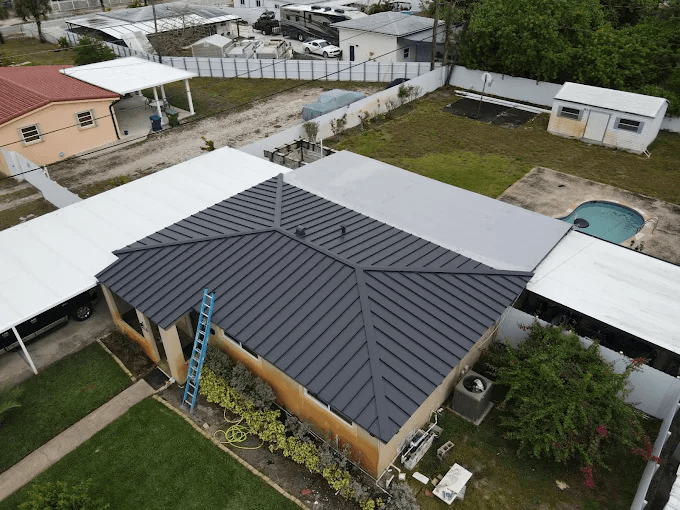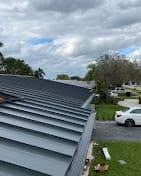Complete New Roof Replacement Guide

Your home’s roof is its first line of defense against rain, wind, heat, and storms. Over time, even the strongest roof reaches the end of its life and requires replacement. A new roof replacement is a major investment, but it also adds value, boosts curb appeal, improves energy efficiency, and safeguards your property for decades to come.
In this comprehensive guide, we’ll walk you through everything you need to know about new roof replacements: signs it’s time for one, the replacement process, roofing material options, costs, FAQs, and tips for choosing the right contractor. By the end, you’ll have a clear roadmap to make an informed, confident decision about upgrading your roof.
What Is a New Roof Replacement?
A new roof replacement involves removing your old roofing system—shingles, underlayment, and sometimes decking—and installing a brand-new system designed to last 20–50 years or more.
Why It’s Important:
Protects Against Leaks: Prevents costly water damage inside your home.
Boosts Energy Efficiency: Modern materials reflect heat and reduce cooling bills.
Improves Home Value: Homes with newer roofs sell faster and for higher prices.
Ensures Safety: Prevents collapse or hazards from storm damage.
Meets Insurance & Building Codes: In Florida, roofs must meet updated hurricane standards.
Knowing when to replace your roof is key to avoiding expensive structural repairs later.
Signs You Need a New Roof Replacement

Look for these warning signs that your roof may be failing:
Missing, cracked, or curling shingles
Water stains on ceilings or walls
Frequent leaks after rainstorms
Sagging rooflines
Excessive moss or algae growth
Roof age: 15–25+ years depending on material
Rising energy bills (poor insulation/ventilation)
If you notice two or more of these, it’s likely time to schedule an inspection with a roofing professional.
Step-by-Step Roof Replacement Process
Replacing a roof isn’t just about putting on new shingles—it’s a detailed process requiring skilled contractors.
Initial Inspection & Estimate
Contractor checks roof condition, ventilation, and structural integrity.Material Selection
Choose between asphalt shingles, metal, tile, or flat roofing based on budget and style.Permitting
In Florida and many other states, roofing permits are mandatory to ensure compliance with building codes.Tear-Off
Old roofing materials are removed, down to the decking. Damaged decking is replaced if necessary.Underlayment & Waterproofing
A water-resistant barrier and flashing are installed for leak protection.New Roofing Installation
Shingles, tiles, or panels are installed according to manufacturer guidelines.Ventilation & Insulation
Proper airflow prevents mold and extends roof lifespan.Final Inspection & Cleanup
Contractors inspect quality, remove debris, and provide warranty paperwork.
The average roof replacement takes 2–5 days, depending on size, complexity, and weather conditions.
Types of Roofing Materials
When considering a new roof replacement, material choice is one of the biggest decisions.
Asphalt Shingles
Most common and affordable
Lifespan: 15–25 years
Wide variety of colors and styles
Metal Roofs
Highly durable and energy-efficient
Lifespan: 40–70 years
Excellent for hurricane-prone areas
Tile Roofs (Clay or Concrete)
Classic look, especially for Florida and Mediterranean-style homes
Lifespan: 50+ years
Heavy, requires strong roof structure
Flat/Low-Slope Roofs
Often used in modern or commercial designs
Requires special membranes for waterproofing
Lifespan: 15–30 years
Each material offers different trade-offs in cost, durability, and aesthetics.
Costs and Pricing Factors
The cost of a new roof replacement varies widely depending on several factors:
Roof Size & Complexity: Larger roofs or steep slopes cost more.
Material Choice: Asphalt is cheapest, tile and metal are more expensive but longer lasting.
Labor Costs: Skilled contractors may charge more but deliver better results.
Permits & Inspections: Required in most cities.
Location: Coastal regions may require stronger materials and reinforcements.
Average Cost in Florida (2025):
Asphalt shingles: $7,000 – $12,000
Metal roofs: $15,000 – $30,000
Tile roofs: $20,000 – $35,000+
Though expensive, new roofs provide an ROI of 60–70% when selling a home and can dramatically lower insurance premiums in storm-prone areas.
Frequently Asked Questions (FAQs)
1. How long does a roof replacement take?
Most residential projects take 2–5 days, depending on complexity.
2. Will homeowner’s insurance cover a new roof?
Yes, if damage is caused by storms or other covered events. Normal wear and tear is not covered.
3. How long does a new roof last?
Asphalt: 15–25 years
Metal: 40–70 years
Tile: 50+ years
4. Can I install a new roof over my old one?
In some cases, yes—but it’s not recommended, especially in Florida, where building codes require a tear-off.
5. Should I stay home during the replacement?
It’s noisy, but safe. Many homeowners choose to leave during working hours.
Tips for Choosing the Right Roofing Contractor

Verify state licenses and insurance.
Check experience with your preferred roofing material.
Read online reviews and ask for references.
Ask about warranty coverage (materials + labor).
Request a detailed, written estimate before signing.
A new roof replacement is one of the smartest investments you can make in your home. It protects your family, improves energy efficiency, boosts resale value, and ensures your property is ready to withstand storms for years to come.
👉 Don’t wait for leaks or storm damage to force your hand. Schedule a professional roof inspection today and take the first step toward a safer, stronger home.
